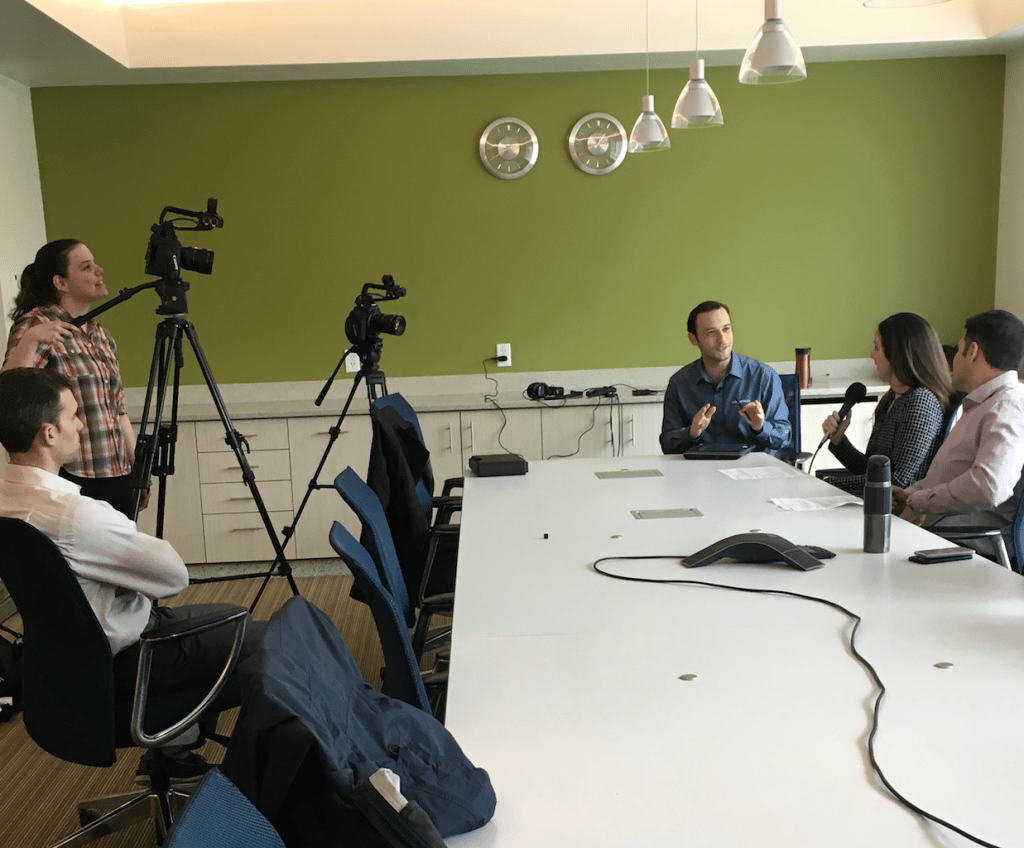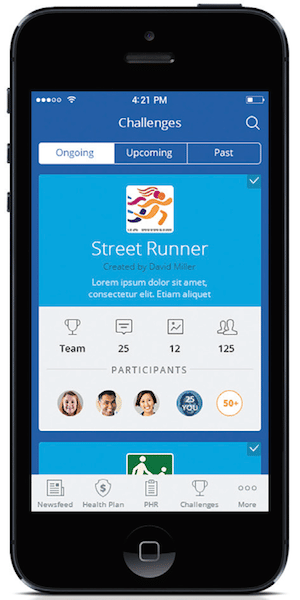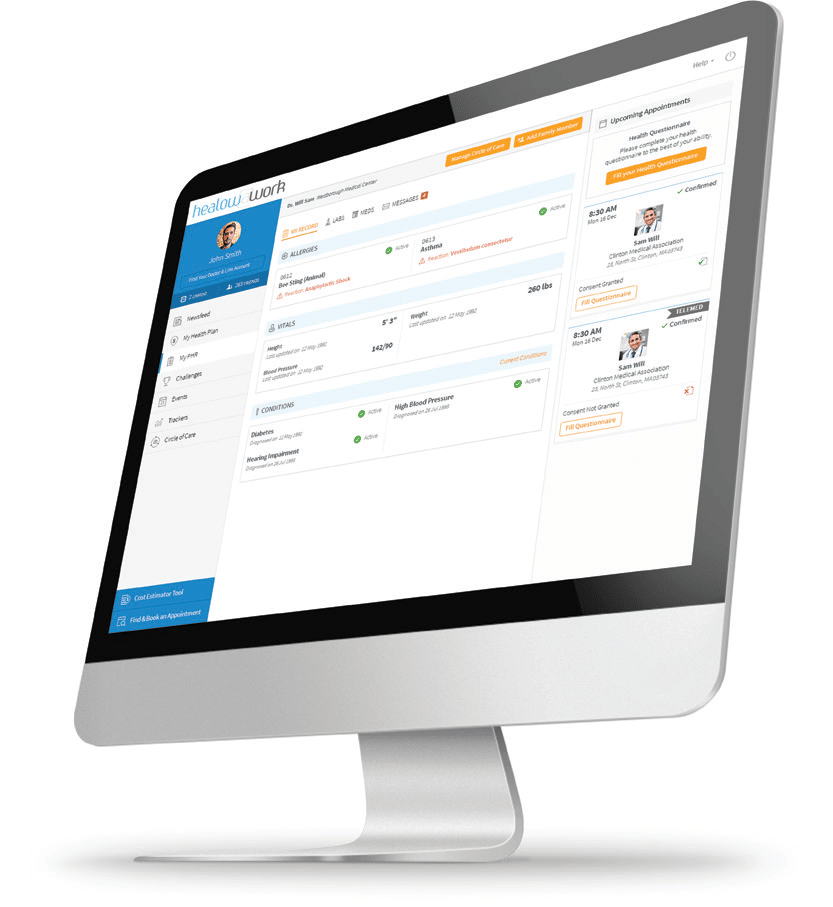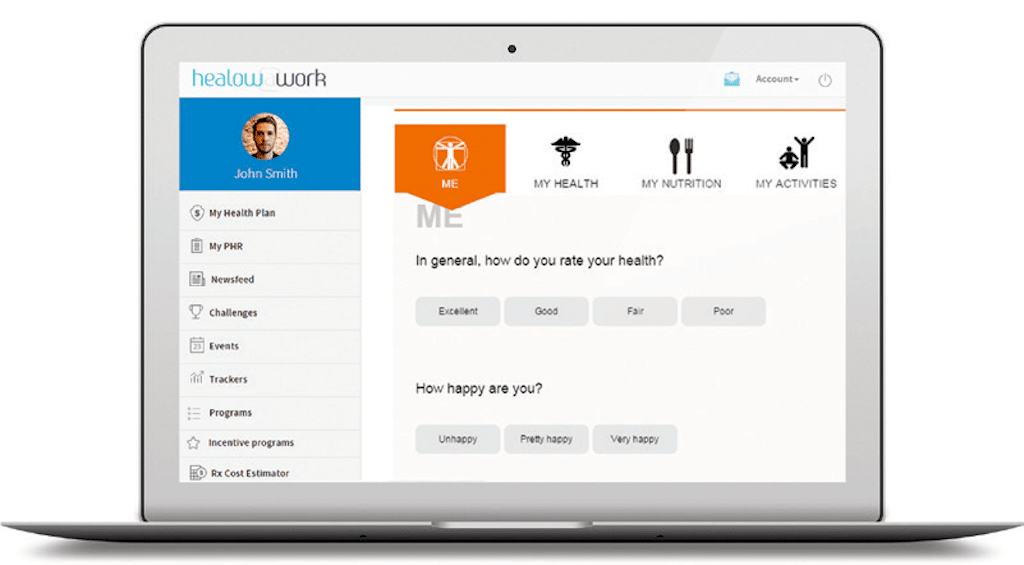Season 3, Episode 5
Published on Wednesday September 14, 2016
In our latest episode of the eCW Podcast, we discuss one of our newer ventures – healow@work. Host Adam Siladi sits down with colleagues Shana Anandjiwala and Kunal Chopra to discuss how practices are using healow@work to improve the health of their employees.
“Any employer that is interested in the health and wellbeing of their employees should be interested in healow@work. But in addition, we feel that health service providers that provide health services to other employers would most particularly be interested in healow@work, since it provides them a platform to deliver health and wellness tools and offerings to their employer or clients.”
— Kunal Chopra, eClinicalWorks project manager

Topics from this episode
Wellness Challenges and Events
Benefits for employers:
- Engage your employees in head-to-head formats with leaderboards and prizes
- Organize and manage company events, making participation easy and efficient
- Administrative access to view employee participation
Benefits for employees:
- Participate in wellness challenges and events
- Link wearables to participate in company competitions
- Motivate one another by sharing pictures and comments for each challenge

Incentive Programs
Benefits for employers:
- Customize an incentive program best suited for your employees
- Program building options include Health Risk Assessment (HRA), educational videos, challenges, and events
- Flexibility to incorporate points and prizes as incentives
Benefits for employees:
- Participate in incentive programs that incorporate food/exercise logging, watching or reading health education material, completing an HRA, or competing in wellness challenges
EHR Integration
Benefits for employers:
- Allow employees to book appointments with providers online
- Option to build a network of preferred providers
Benefits for employees:
- Complete integration between healow and the employee’s
- Personal Health Record (PHR)
- Exchange secure messages with providers
- Book an appointment with a provider or service

Cost Transparency (Medical & Prescription)
Benefits for employers:
- Analyze overall health of the company with easy-to-use executive dashboards
- View metrics like service utilization, pharmacy costs, and inpatient/outpatient costs
- Access detailed analysis of company data
Benefits for employees:
- View their health plan’s total paid cost with easy-to-use dashboards
- See utilization by all covered family members including inpatient/outpatient claims, medications, and more
- View historical claims by provider, date, and cost
- Book an appointment with a provider or service
Health Risk Assessment (HRA)
Benefits for employers:
- NCQA Certified Health Risk Assessment
- See overall population health of your employees
Benefits for employees:
- Identify health risks and ways to improve quality of life
- Easy-to-understand risk reporting

Adam: A successful company is greater than the sum of its employees, and much more so when those employees are healthy and connected with the company culture. I’m Adam Siladi, and today I’m speaking with Shana Anandjiwala and Kunal Chopra, who have been working to coordinate employee health with company goals through healow@work. Thanks for being here today.
Shana: Hi Adam.
Kunal: Thanks for having us.
Adam: So people may or may not be familiar with healow to begin with, much less, healow@work. What’s healow’s mission and how does healow@work expand on that?
Kunal: healow’s mission is to help providers better engage their patients — by providing them access to the health record, ability to book appointments online, and to share their health and wellness data. healow@work expands on that by allowing employers to do the same thing with their employees.
Adam: So, where did this idea come from? Where was the generation? Why did we decide this is important?
Shana: I actually work on our wellness team here at eClinicalWorks, and what we’ve found a couple years ago was that we needed a better way to inform all our employees about challenges and events that we were having. And also, we saw that our healthcare costs were rising, so we wanted a better tool to manage both of those. And in 2014, we went live with about 1,200 of our employees at our Westborough location, and since then, we’ve gone live across the country with all of our other locations as well.
Adam: So, what are some of these activities and events, these wellness events that you’ve organized through healow@work?
Kunal: healow@work allows you to run challenges and events. Challenges essentially allow employees to compete against one another in things like who can walk the most steps, who can walk the most distance? Events are essentially company events that you can run and track to see employee participation. We also allow employees to share their wearable device data, so if you have a fitbit, a withings, a jawbone — you can link that to healow@work and we can actually grab the data off the device and allow you to compete in challenges using that data. We also require access to cost transparency tools, so if you want to look up prices for prescriptions, you are able to do that as well through healow@work, and these are all the things we’re doing today with our own employees at eClinicalWorks.
Adam: Okay, what about some fun activities and things like that?
Shana: Some activities that we do today, a lot of the time we do step challenges, so all the employees that have some sort of wearable step-tracking device, they hook those one and we do step challenges in that way. We also do all of our events on healow@work so if we have a yoga series or some sort of Zumba class, we put all those on healow@work and then the registration happens that way.
Adam: I’ve noticed that around holiday time, we see announcements for pumpkin painting and gingerbread houses, and those types of things also fall under healow@work, as well, right? You see a lot of engagement with those activities?
Shana: Absolutely, that’s how we get most of our employees on healow@work, actually.
Adam: So you’re making it fun for everybody. So, tell me about the employee experience on healow@work. I know I can be invited to some of these events and I can participate in them, I can share some of my data, but what does the employee see or how do they navigate through healow@work?
Shana: I would say, like I said, most of our common things that people actually go on healow@work for are the challenges and the events. The employees have the ability to create teams when we do some sort of step challenge like that, they can create a team, they can name their team, they can upload a picture, and that really engages them to do that. Also, when they sign up for their events, they can see who’s already signed up; there’s a whole participation list, so they might say ‘Oh yeah, if this person’s doing it, I want to compete against them or I want to join them, or I don’t.’ But hopefully they do! Then they can also add a picture or comment or those types of things on the events, as well. We can also link to their personal health record. So, if they see a provider that is on eClinicalWorks, and they’ve enabled them for Patient Portal, they can see their health record on healow@work.
Adam: So, we’re trying to tap into that competitive spirit there, with the employee engagement, but also give them additional tools to bring in some of the information that they might be searching for in other places, like their Patient Portal. If I’m an employer that’s using healow@work for my employees, I can invite my employees to those events, and hopefully they get the fire lit under them and they want to participate, but why wouldn’t I just send out an email blast to do the same thing?
Kunal: I think doing it through email is the most common method today. The drawback there is that now you’re receiving email replies from every employee that wants to participate, which can be really hard to track. What we do is through the events in healow@work, we allow employers to track these participants online, see a running list of employees who have signed up — they can send messages to these employees, if they know of any updates, employees can share comments with one another. Think of it like a social platform, almost — it’s a worksite with a little bit of social experience behind it. Employees can also do things such as share pictures about the event, so if you have pictures you took during the event, you can also upload those online, on the events pages.
Adam: Do the employees get anything else out of this besides just knowing what events are happening and being able to sign up for them?
Shana: I think the social aspect is good for it, as well, that they can become active with one another — we see a lot of that, in groups, people do better.
Adam: Kunal, you mentioned that prescription prices were available through healow@work — as someone with an employer-sponsored health plan, or really any health plan for that matter, what difference does it make to me, whether I fill my prescriptions at CVS or Walmart or Target?
Kunal: That’s a good question, Adam. There’s always a cost beyond the copay, so most of us are on an employee-sponsored health plan, don’t usually see any cost beyond our regular $20 or $25 copay, depending on your plan. But the thing is that if a prescription costs $40 at one pharmacy and $80 in another, even though your copay is the same, the employer ends up spending another $40 filling that same prescription. With healow@work, we give the employee a tool to allow them to search for cash prices for drugs and to see what pharmacies might carry that same drug for a lower cost, therefore encouraging them to go to these pharmacies that are on the lower tier of the cost structure; this saves the company money, which then gets given back to the employee, so it’s a win-win situation, the employee is saving the company money, and the employer, in turn, is investing back into the employees.
Adam: So, as an employer, I might do everything I can to communicate to these employees that this is good for the company, this is good for you, you can save this money, you can have this type of an impact, but healow allows me, as an employee, actually to see the difference there and maybe that has more of a resonance?
Kunal: Yes and, in addition to what I mentioned, it also can save you money, too — I also want to mention that there are drugs which could possibly fall below your copay amount, so if there’s a drug available for $15, and your copay is $20, you’ll save $5 yourself. Now, there are pharmacies that usually tend to carry the same prescription for higher prices, so healow@work again arms you with the information for you to make these decisions, better decisions, saving yourself money and the company money.
Adam: Sometimes, in the news, we hear stories of people who want less regulation, less oversight from outside groups and entities, and I can kind of see this maybe playing into it, with an employer encouraging employees to take a certain form of action. Do you think that employers have a role to play in employee health and what might that role be?
Shana: I think they do. We spend so much time at work, you know, at least 40 hours at work every week and so, I think that does play an important role during that time to be able to motivate employees to become active and in that environment of helping each other stay active, I think, is also important.
Adam: Tell me about some of the tools that are built into healow@work for an employer, who’s looking to encourage their workers to make some different health choices.
Kunal: We also allow employees to access education materials in the form of articles and videos, think of it like a WebMD that’s built right into healow@work. They can look up information about diabetes, obesity, any chronic condition that they’re interested in learning more about. We also allow employers to learn about wellness programs that target chronic conditions. If they have a large diabetic population or obese population, they can create wellness programs to target these groups and help them run through activities or participate in events or challenges to better improve their health. Lastly, I think this is one of the most important things, is the ability to create incentive programs to incentivize their employees to do certain things. You can create an incentive program which requires employees to do certain things in a time period, such as a calendar year, that can include participating in a challenge and an event, linking a wearable device, exercising and as they go through these activities, they will be rewarded, and they can use these rewards to, perhaps, cash in for prizes that the employer might offer.
Adam: What would some of those incentives look like? What are we talking about, how are we rewarding people?
Shana: We’ve seen other employers give cash incentives, some people give a day off for an incentive, premium reduction as an incentive — those are probably the top three that we’ve seen, but you could also do material things, like a wearable device or a tee-shirt, anything like that.
Adam: So how would I know which of my employees deserve this incentive?
Shana: So we have reports at the end of the incentive period so we would be able to run the report and see who qualify for that particular incentive. You set it up at the beginning of the year.
Adam: OK, so I’m guessing the people who participate in the most activities or make the most steps are going be high on that?
Shana: Yeah, it depends on how you set up the incentive at the beginning of the year. If you want to give points for taking the health assessment, for competing in one of maybe 10 challenges, for competing in a wellness program. Depending on how you set that up at the beginning of the year, you can vary how you want to give out your incentives.
Adam: What are some of the other features of healow@work that we might not have discussed yet?
Shana: We also have reports that we haven’t really touched on yet. So, we have participation reports, so as an employer I can run those to see where most participation is in a challenge or event — so I could run future events of those kinds, if, obviously, people like them. We also have an aggregate health risk assessment report, so the employer, again, just like Kunal was talking about, a personal report that an employee gets, after they take the health risk assessment, the employer can actually get the aggregate report, they can see their population — what the healthy areas are and where the risky areas are.
Adam: And, of course we’re talking about de-identified data, at this level, the employer doesn’t know which people have responded to which items. So, based on your experience so far — and it sounds like we have a lot of things that are available for the employees, for the employers — who is most interested in healow@work at this point?
Kunal: From our perspective, we feel that any employer that is interested in the health and wellbeing of their employees should be interested in healow@work. But in addition, we feel that health service providers that provide health services to other employers would most particularly be interested in healow@work, since it provides them a platform to deliver health and wellness tools and offerings to their employer or clients.
Adam: It sounds like that’s another level above what we’ve already been discussing with healow@work. How would some sort of a health service provider manage something like that?
Kunal: it’s common for health service providers to set up onsite clinics, on their client sites, This clinic offers health services in the form of acute condition care, you know, if you’re suffering from a cold or a cough or the flu, these are acute conditions that you can go into their onsite clinic and be seen by the nurse practitioner, the staff in that clinic, or the physician’s assistant. The healow@work tool allows the client’s employee population as a whole and not just for individual events such as these acute conditions; you can motivate them to exercise, eat better, to take better care of themselves. So we’re looking at this from the perspective of an entire population versus just each event or any patient that might be suffering from an acute condition.
Adam: People who are interested in healow@work will be wondering, how will I know one of these things are working. What do you look for?
Shana: We feel that as long as the employees are engaged, and we can get them maybe to move a little bit more, eat a little bit better and are feeling good about themselves, that, that in itself, is such a huge bonus to healow@work.
Kunal: if you’re an employer looking to improve the health of your employees, there are a lot of tools in the market that offer you the ability to do things like offer challenges, using wearable device data, or run wellness programs, or to allow your employees to complete a challenge activity. While these tools do exist, there aren’t any tools that allow you to do all of these things at once, and that’s why healow@work offers you a complete package to allow you to run challenges, to run events, to complete HRAs, to run wellness programs and incentive programs, and provide cost transparency tools on top of that.
Adam: So, if I want to learn more about what healow@work has to offer, and it does sound like it’s a lot, where would I go?
Shana: you can go on healow.com and click on the ‘Are you an employer?’ button, or you can go to our corporate website, which is eclinicalworks.com and you can click on healow@work.
Adam: Well we certainly hope to see more out of healow@work in the future and you can also find our podcasts at my.eclinicalworks.com, as well as on YouTube and for download on iTunes. Shana, Kunal thank you so much for being here today. For the eClinicalWorks Podcast, I’m Adam Siladi.

